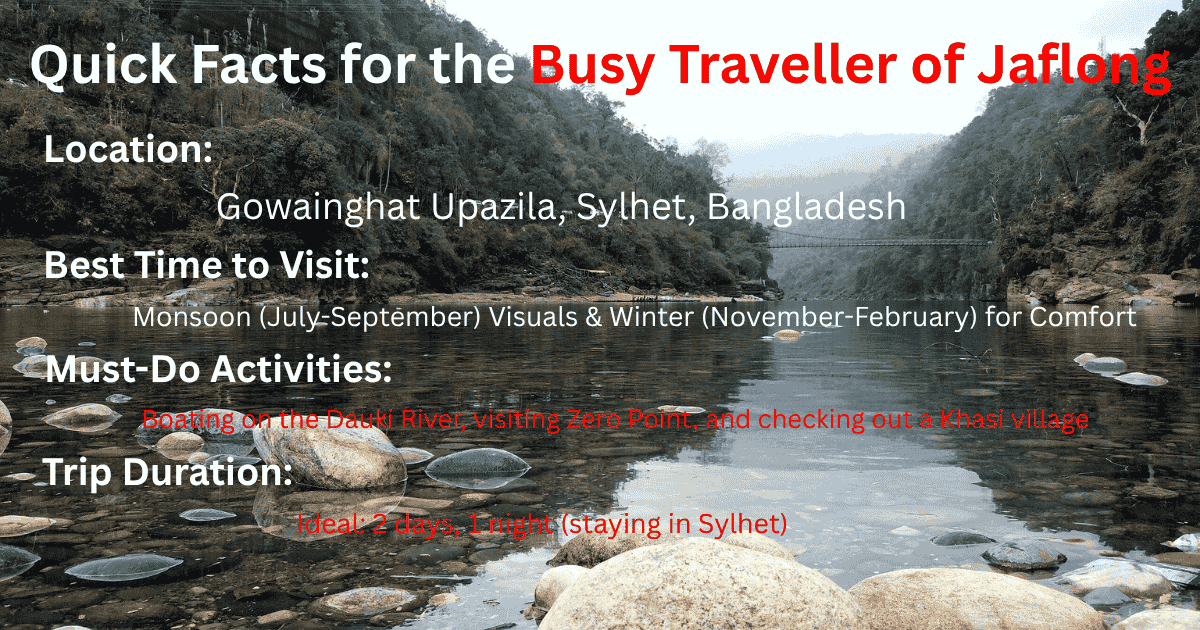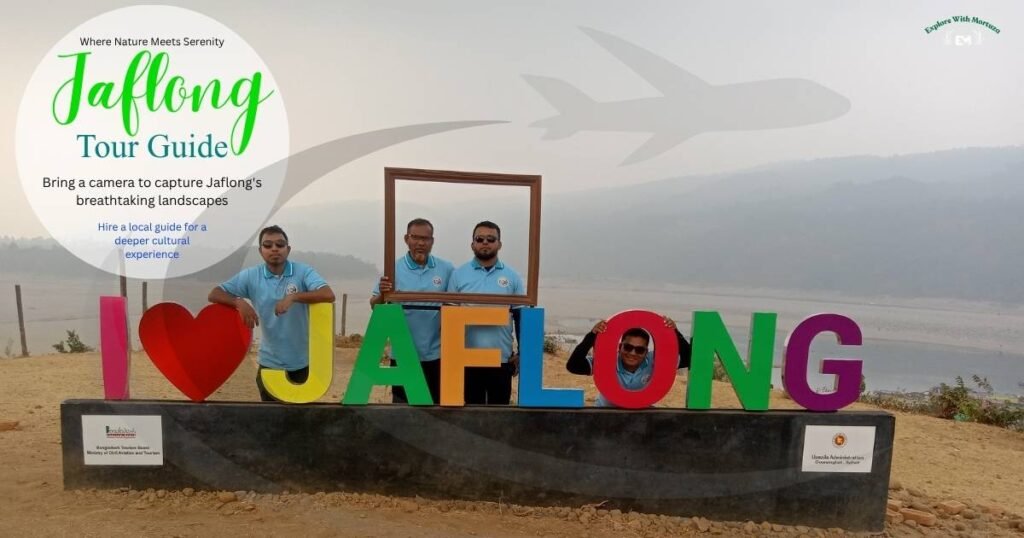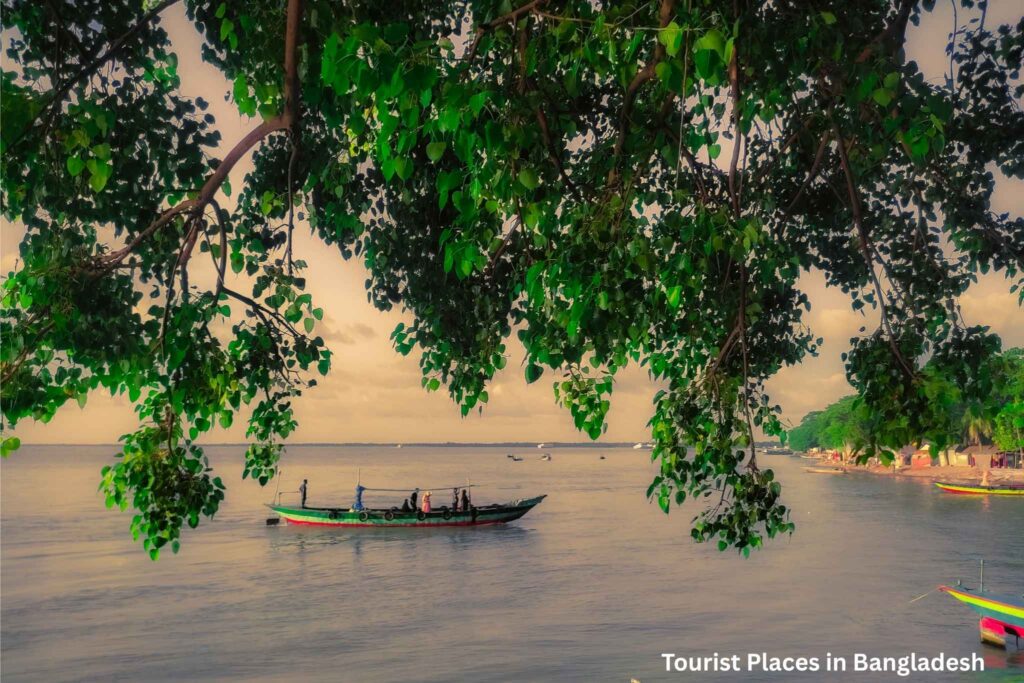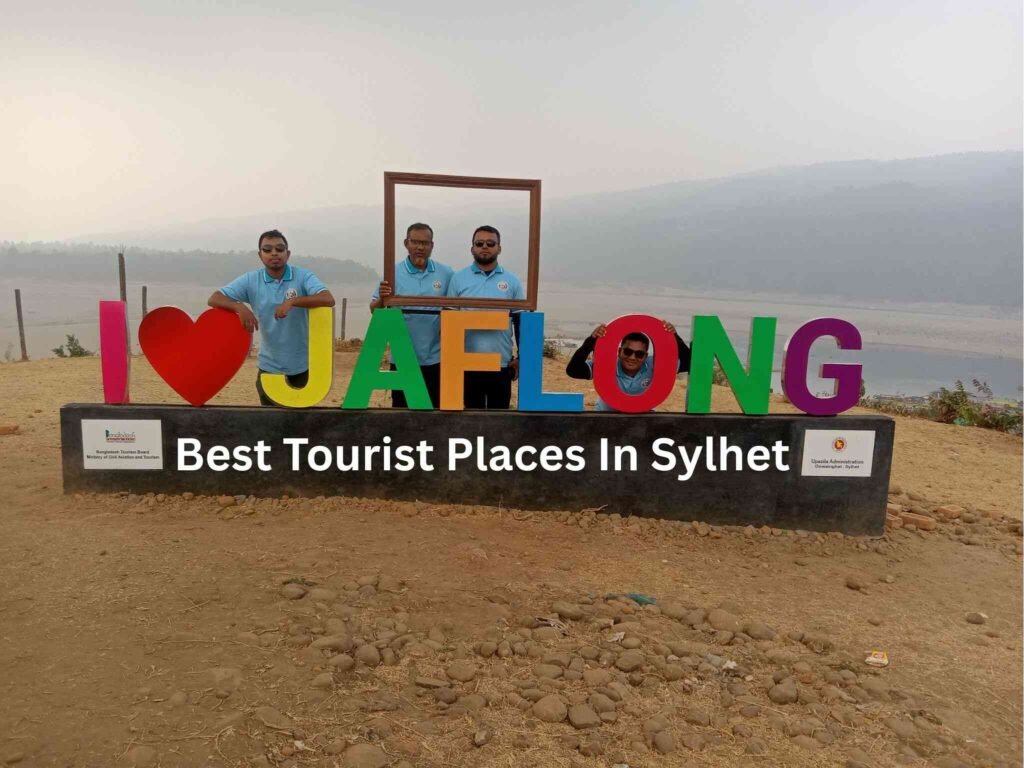I still remember the first time I saw it, the magical moment when my eyes looked through the water of the river and counted the colorful stones resting at the bottom as if there were no water at all. Above, the majestic Khasi hills stood like silent guardians against a blue sky. This is the picture of Jaflong, a stunningly beautiful spot in Sylhet, right on the border between Bangladesh and India.
Locals affectionately call it Prokriti Konna, meaning “Daughter of Nature.” As you read this Jaflong tour guide, you will understand exactly why it earned such a perfect name. This guide is your complete companion, providing everything you need to know, from reaching this natural wonder and discovering its best sights to finding a good meal and staying safe on your adventure.
Jaflong: Quick Facts for the Busy Traveler

Location: Gowainghat Upazila, Sylhet, Bangladesh
Famous For: Crystal-clear Dauki River, stone collection, views of the Khasi Hills, and tea gardens.
Best Time to Visit (Visuals): Monsoon (July-Sept) for lush greenery & full rivers.
Best Time to Visit (Comfort): Winter (Nov-Feb) for pleasant weather & easy travel.
Must-Do Activities: Boating on the Dauki River, visiting Zero Point, and checking out a Khasi village.
Trip Duration: Ideal: 2 days, 1 night (staying in Sylhet); Possible: 1-day trip from Sylhet.
Why You Absolutely Must Visit Jaflong
Jaflong is more than just a pretty place; it’s a destination that offers a rare combination of natural wonder, photographic opportunity, and cultural discovery. This isn’t just about seeing a river or a hill; it’s about witnessing how they come together to create a scene unlike any other in Bangladesh. From the incredible clarity of the water to the unique lifestyle of the local Khasi community, every part of Jaflong gives you a reason to visit.
The Unique Landscape: Imagine a real-life painting where mountains, a river, and the sky come together perfectly. Jaflong offers a one-of-a-kind scene with the river flowing down from the Indian hills, carrying with it millions of colorful stones that settle on its bed. This combination of a clear river, smooth stones, and a backdrop of deep green hills is something you won’t find anywhere else in the country.
A Photographer’s Paradise: For anyone with a camera, Jaflong is a dream come true. The reflections of boats and clouds in the clear water create amazing shots. The sight of local workers collecting stones from the river tells a powerful story. Moreover, the endless green of the nearby tea gardens provides a peaceful and beautiful subject for your lens.
A Touch of Culture: A trip here is not just about nature; it’s also a chance to get a small peek into the life of the indigenous Khasi people. Seeing their organized villages and learning about their way of life adds a special cultural layer to your journey, making it a more meaningful experience.
Top 5 Unforgettable Places to See in Jaflong
Your journey to Jaflong is defined by its incredible sights, each offering a unique experience. This list covers the absolute must-see locations that make this place so special. From the legendary clear river and its border point to the serene tea gardens and cultural villages, these five spots are the foundation of any great trip. My personal experience says you should not miss a single one of them to get the full picture of Jaflong.
The Dauki River & Zero Point
What it is: This is the main attraction of Jaflong. The Piyain River, which is part of the larger Dauki river system, flows from India into Bangladesh here. The Zero Point is the official border marker between the two countries.
Why it’s special: The water is unbelievably clear. My first time boating here felt like floating on a sheet of glass. You can see every single stone on the riverbed, which is an amazing feeling.
Pro-Tip: You should definitely hire a boat for a one-hour trip. It’s the best way to see the beauty of the river and get close to Zero Point. Remember, the price is almost always negotiable, so don’t hesitate to bargain politely for a fair rate.
The Foothills of the Khasi Hills
What it is: The spectacular mountain range in Meghalaya, India, that creates the dramatic background for all your Jaflong pictures.
Why it’s special: Standing before these hills makes you feel small and fills you with a sense of wonder at nature’s scale. During the rainy season, you can often spot beautiful waterfalls running down the green slopes, which is a truly special sight.
Pro-Tip: For the best photographs of the hills, try to be on a boat in the middle of the river during the morning. The soft morning light makes the hills look absolutely magical.
Sangrampunji Waterfall (Mayabi Jhorna)
What it is: A lovely waterfall, also known as Mayabi Jhorna, that you can reach with a short walk or a boat ride. Although it’s technically on the Indian side of the border, you can see and access it from the Bangladesh side.
Why it’s special: It offers a wonderful opportunity to see a real mountain waterfall up close without having to go on a difficult trek. The sound and sight of the falling water are very refreshing.
Pro-Tip: This waterfall is most impressive during the monsoon season when it’s full of water. If you visit in the dry winter, it might be just a small stream of water.
The Local Tea Gardens
What it is: The area around Jaflong is dotted with lush, green tea estates that stretch for miles.
Why it’s special: These gardens offer a calm and pretty change of scenery from the busy river area. They are perfect for a quiet walk, breathing in the fresh air, and taking some beautiful pictures amidst the greenery.
Pro-Tip: Simply ask your CNG or auto-rickshaw driver to make a quick stop at one of the tea gardens, either on your way to Jaflong or on your way back to Sylhet.
Khasia Palli (Khasi Village)
What it is: This is a village where the indigenous Khasi community lives.
Why it’s special: It gives you a window into their interesting matriarchal culture, where family lines are traced through the mother. You can observe their clean, organized lifestyle and see their famous betel leaf plantations.
Pro-Tip: Always be respectful when you visit the village. It is polite to ask for permission before you take pictures of people or their private homes. You can often buy fresh betel nuts and delicious local honey directly from the villagers.
How to Plan Your Trip: A Step-by-Step Guide
A great trip requires good planning, and this guide will walk you through every step. Knowing the best time to go, how to get there, where to stay, and what to eat can make your journey smooth and enjoyable. I’ve broken down all the essential information you need to arrange your travel from major cities like Dhaka to the final destination, removing the guesswork so you can focus on the amazing experience ahead.
Best Time to Visit Jaflong
Monsoon (July-September): For nature lovers, this is the peak season. The rain makes the hills and tea gardens intensely green, the rivers are full, and the waterfalls are at their most powerful. The fresh, clean look of nature after a rain shower is something to behold.
Winter (November-February): If comfort is your priority, winter is the best time. The weather is mild and pleasant, the skies are usually clear, and the risk of rain is very low. This makes it easier to travel and walk around.
Avoiding Extreme Seasons: I would suggest avoiding the peak summer months (March-May). The temperatures can get quite high, making travel uncomfortable. This period can also see a lot of tourist traffic, making the place feel crowded.
How to Reach Jaflong
Step 1: Getting to Sylhet:
From Dhaka: You have several good options. Buses (both AC and Non-AC) leave regularly from Gabtoli and Sayedabad terminals, taking about 6-8 hours. Trains from Kamalapur Station are a comfortable alternative. For the quickest journey, you can take a short flight from Hazrat Shahjalal International Airport to Sylhet.
From Chattogram: You can find direct bus and train services connecting Chattogram to Sylhet.
Step 2: Sylhet City to Jaflong:
By Bus: This is the most budget-friendly way. Head to the Kadamtali bus stand in Sylhet to find buses heading to Jaflong. It’s a local ride, so expect a journey of about 2-3 hours.
By CNG/Auto-rickshaw: A great choice for a small group of 3-4 people. It’s faster than the bus and gives you the freedom to stop wherever you like for photos.
By Private Car/Microbus: This is the most comfortable option, especially for families or larger groups. You can rent one for the whole day, which allows you to travel at your own pace and visit other spots along the way.
Transportation in Jaflong
Local Transportation: Once in Jaflong, you can easily find local buses, CNGs, and legunas (a type of shared taxi) to get around. Prices are generally low.
Walking or by Cycle: The main tourist area is small enough to be covered on foot. Walking along the river is a wonderful experience. You might also find some places to rent a cycle for a small fee.
Ridesharing and Other Options: While app-based ridesharing isn’t common, you can hire a CNG for a few hours or connect with local guides who can arrange transportation for you.
Where to Stay: Jaflong vs. Sylhet City
Staying in Jaflong: Options here are quite limited. There’s the government-run Parjatan Motel and a handful of other basic local hotels. This choice is for the more adventurous traveler who wants to wake up to the immediate sights and sounds of Jaflong.
Staying in Sylhet (Recommended): I almost always recommend staying in Sylhet city. It’s the more practical choice for most people. The city has a much wider variety of hotels to fit every budget, from simple guesthouses to luxury hotels. You will also find better restaurants, and it makes a great central point for visiting other attractions around Sylhet.
What to Eat in Jaflong
The food scene in Jaflong is simple and local. You’ll mostly find Bengali cuisine, with a special focus on fresh fish caught from the river.
I recommend trying a traditional meal. Look for a small restaurant near the river and order a plate of plain rice, dal (lentil soup), some bhorta (mashed vegetables), and a piece of freshly fried river fish. It’s a simple yet delicious meal.
It’s a good idea to carry your own bottle of water and some light snacks, as the choices in Jaflong can be quite basic and limited.
Activities to Do in Jaflong
Beyond just seeing the sights, Jaflong invites you to participate in its natural setting. Several simple yet deeply satisfying activities connect you with the environment. Whether you prefer a quiet walk, a gentle boat ride, or the simple joy of collecting a unique stone, these activities complete the Jaflong experience. They allow you to slow down, breathe in the fresh air, and make some wonderful memories during your visit.
Nature Walks & Trekking: If you are feeling adventurous, you can ask locals about safe trails for a walk or a small trek into the nearby hills to get a different view of the area.
Boating in the Dauki River: This is a must-do. Taking a boat tour on the clear water is the signature experience of Jaflong. It lets you see the natural beauty from the best possible angle.
Stone Collection: The colorful, smooth stones of Jaflong are famous. Picking up a few unique stones is a great way to take a natural souvenir back home with you.
Bird Watching and Photography: For nature lovers, Jaflong is a fantastic spot for bird watching, especially during the cooler months. The scenic beauty offers endless opportunities for amazing photographs.
Recommended Trip Duration: How Many Days Do You Need?
Weekend Getaway (2-3 Days): This is the perfect amount of time for a quick trip. On Day 1, travel to Sylhet and check into your hotel. On Day 2, take a day trip to Jaflong, see all the main spots, and return to Sylhet by evening. On Day 3, you can either head back or visit another nearby place before leaving.
Extended Stay (4-5 Days): If you have more time, you can truly soak in the beauty of the region. Spend a full day in Jaflong, and then use the following days to make day trips to other amazing places like Lalakhal, Ratargul Swamp Forest, and Bisnakandi.
Travel Tips for Visiting Jaflong
A little preparation goes a long way in making your trip to Jaflong perfect. These practical tips, born from my own travels, cover everything from what to pack to how to interact with locals. Following this advice will help you avoid common issues, stay safe, and be comfortable throughout your journey. Think of this as your personal checklist for a hassle-free adventure, allowing you to relax and enjoy the incredible scenery around you.
Packing Essentials:
- Carry Cash: Many small shops, restaurants, and boatmen only accept cash. It’s wise to carry enough with you.
- Bargain Respectfully: It’s common to negotiate prices for boat rides and local CNG rentals. Do it with a smile.
- Wear Sensible Footwear: You will be walking on uneven ground and slippery, wet stones. Good walking shoes with a solid grip are very important.
- Pack accordingly: A raincoat or umbrella is a must during the monsoon. Sunscreen, sunglasses, and a hat are essential for the sunny winter days. Mosquito repellent is also a good idea.
Cultural Etiquette:
The local people are generally friendly. Be polite, smile, and respect their customs, especially when visiting the Khasi village.
Health and Safety:
Be careful with street food and drink only bottled water to stay healthy. During the monsoon, be aware of your surroundings, as the ground can be slippery.
Language Tips:
Most people speak Bengali. Knowing a few basic phrases like “Kemon achen?” (How are you?), “Dhonnobad” (Thank you), and “Koto?” (How much?) can be helpful and is appreciated by the locals.
What to Avoid and Travel Risks
While Jaflong is a beautiful and generally safe place, being aware of potential risks is smart for any traveler. This section highlights a few important things to keep in mind for your safety. These are simple but crucial points, like respecting international borders and being careful on wet surfaces. Knowing what to avoid will help you prevent accidents and allow you to enjoy your trip with complete peace of mind and security.
Don’t Cross the Border: When you are at Zero Point, be very mindful of the border markers. Do not cross into Indian territory, even by accident.
Be Careful on Wet Rocks: The rocks and stones in and around the river are extremely slippery when wet. I’ve seen many people slip and fall. Walk slowly and carefully.
Avoid Traveling After Dark: The road connecting Jaflong to Sylhet is not well-lit in many areas. For safety, it is best to finish your visit and start your journey back to Sylhet well before sunset.
Beyond Jaflong: Exploring Nearby Attractions
Your adventure in Sylhet doesn’t have to end with Jaflong. The region is blessed with several other natural wonders that are just a short trip away. If you have an extra day or two, I highly recommend checking out these nearby spots. Each one offers a different kind of natural beauty, from the emerald waters of Lalakhal to the mysterious swamp forest of Ratargul, making your overall trip to the region even more memorable.
Lalakhal: Located nearby, this place is famous for its stunning, emerald-blue river water. You can easily combine a trip to Lalakhal with your Jaflong visit.
Ratargul Swamp Forest: Known as the “Amazon of Bangladesh,” this is a unique freshwater swamp forest. A boat ride through the submerged trees is an otherworldly experience, especially for nature lovers.
Bisnakandi: Another beautiful spot where mountains and water meet. It is similar to Jaflong with its stone beds and clear water, but offers a different, more panoramic view that many find just as beautiful.
Local Tour Guides: Is Hiring One Worth It?
Hiring a Jaflong local tour guide can be a very good idea. These guides possess insider knowledge and can show you hidden spots you might otherwise miss. They can also help you negotiate prices for boats and transport, making your trip smoother. You can usually find reliable tour guides in Jaflong near the main tourist spots or by asking your hotel in Sylhet for a recommendation. I remember seeing a great perspective on this in a video from Explore With Mortuza. A guide can arrange everything from trekking to boat tours, which saves you a lot of hassle.
Conclusion: Why Jaflong Should Be Your Next Travel Destination
In summary, Jaflong is more than just a tourist spot; it’s an experience that touches your soul. It’s a place where you can witness the raw, unspoiled beauty of nature. Whether you are a nature enthusiast, a photographer, or just someone looking for a peaceful getaway, Jaflong offers something special. My final tip is to plan your trip during your preferred season, take your time, and allow yourself to get lost in the sights and sounds of the Daughter of Nature.
Frequently Asked Questions (FAQs) About the Jaflong Tour Guide
What is the best time to visit Jaflong?
The best time depends on what you want to see. Visit during the monsoon (July-September) for lush greenery and full waterfalls. For comfortable weather and easy travel, the winter season (November to February) is ideal.
How can I reach Jaflong from Dhaka?
First, you need to get to Sylhet from Dhaka by bus, train, or plane. From Sylhet’s Kadamtali bus stand, you can take a local bus, or you can hire a private CNG or car for a more direct 2-3 hour journey to Jaflong.
Are there any luxury accommodations in Jaflong?
No, there are no luxury hotels directly in Jaflong. Accommodation options are very basic. For luxury and a wider range of choices, it is best to stay in Sylhet city and make a day trip to Jaflong.
What is the significance of the Liberation War Martyrs’ grave in Jaflong?
There is a freedom fighters’ graveyard in Jaflong that holds historical importance. It is the resting place of freedom fighters who were martyred during the 1971 Liberation War of Bangladesh, making it a place of national reverence.
Is it safe to visit Jaflong during the monsoon season?
Yes, it is generally safe, and it’s also the most beautiful time to visit. However, you must be extra cautious as the paths and rocks become very slippery. Also, be prepared for rain with appropriate gear.
Start planning your trip to Jaflong today and experience the best of nature! Have you been to Jaflong? Share your experiences or ask any questions in the comments below. We’d love to hear from you!


